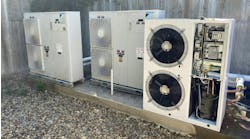You have to love the rich people, at least the ones that love to spread the wealth around. Sometimes they even spend lots of money on hydronic upgrades to their fabulous residences, because they have to outspend their rich friends. It’s actually a municipal ordinance to add on to their house every six years in the tony neighborhood where a lot of them live. Well, it really seems that way.
The title of this column comes from the fabulous 1973 song by the Oakland-based band Tower of Power, regretting the rapid change in what is considered “hip.” The need to have the very latest and greatest is what drives this market. Be the first on your block to have the floor of your outdoor patio heated, because you want to sit outside in the cold but have warm feet while you wave to the neighbors.
Over a hundred years ago, it was hip to be the first one in town to have central heat in your mansion. No more servants hauling coal through the house to every fireplace all winter long. Just have the man servant start a coal fire in the steam boiler in the fall and keep it stoked during the cold weather. Central heat has been hip ever since, but the coal fire long ago became passe.
How and what we heat with hydronics has changed over the years and I will predict that it will continue to evolve. One example that comes to mind is a mansion that has had a few different heating systems through my career. It was built in the 1920’s by a grocery tycoon to stand out from the crowd, a classic Tudor with plenty of bells and whistles.
In fact, it had one of the largest private pipe organs of its time in the music room. That fact was pointed out to me over 30 years ago by the caretaker as we surveyed all the cast iron radiators in the house. The only room without a radiator was the one added into the house back in the ‘60s when it was hip to have a large soaking tub in the middle of a room. Thirty years later, that’s no longer hip, and that room is gone.
The oil-fired steam boiler needed to be replaced back then. Twenty-some years later, a new owner was installing a geothermal system to automatically heat and cool the house, now with seven zones of control. Each zone has an air handler with a DX coil for the heat pump and a hot water coil for the new high efficiency boiler system. That setup was very hip then.
The new boilers also heated the domestic hot water through two 120-gallon indirect water heaters. I designed the whole setup with the hippest components of the day, including a hydraulic separator and a variable speed pump for the seven zone valves. The new owner loved it, or at least he never complained.
Two years ago, I got a call from a contractor we do a lot of high-end work with. He was asking about heating the water in an indoor exercise pool with an existing high efficiency hot water boiler system. As we talked I realized it was the grocery tycoon’s old house. Turns out it had been sold again, and the new owner had big plans. He or she wanted to be the new hip cat in the neighborhood.
It took a year or so of plan changes before the size of the pool, the pool’s water temperature and the type of filtration was finalized. You need to know all that info to size and price a pool heat exchanger that works off a hot water boiler. The size and temperature give us the btu requirement, while the filter type tells us whether special materials are needed. A pool filtered with chlorine uses a cheaper heat exchanger than a pool filtered with salt. These are the details that keep you out of trouble.
The heat load for the pool was not that much since it was inside and in the basement below grade. They wanted to know if they could just add an eighth zone to the variable speed pump loop since there was an extra spot on the existing zone valve relay panel. I told them that there a few more things to check to make it work right, hydronic standards like water temperature and pressure drop.
Hooked up with the back-up heating coils, the heat exchanger would get the same water temperature as the other seven zones, which was verified to be enough to keep the pool at its temperature. The flow rate required by the heat load determined the pressure drop through the heat exchanger and zone valve on the boiler side. The variable speed pump had plenty enough differential pressure to overcome the friction loss through the new pool’s water heating zone.
Everything checked out, so that was the extent of the newest changes to the boiler system at this hundred-year-old mansion. A “tunnel” was added to connect the main house with a new carriage house. They put two bowling lanes in the tunnel, because what else says hip more than a bowling alley in your basement.
They got their system done, but unfortunately I didn’t find the time for my home project yet. I’m hoping to start soon, but chances are you won’t be reading about my hipper than hip set up for a couple of months. Next month I’ll write about a house that keeping its steam system. Not hip but still viable.
Patrick Linhardt is a thirty-seven-year veteran of the wholesale side of the hydronic industry who has been designing and troubleshooting steam and hot water heating systems, pumps and controls on an almost daily basis. An educator and author, he is currently Hydronic Manager at the Corken Steel Products Co.


